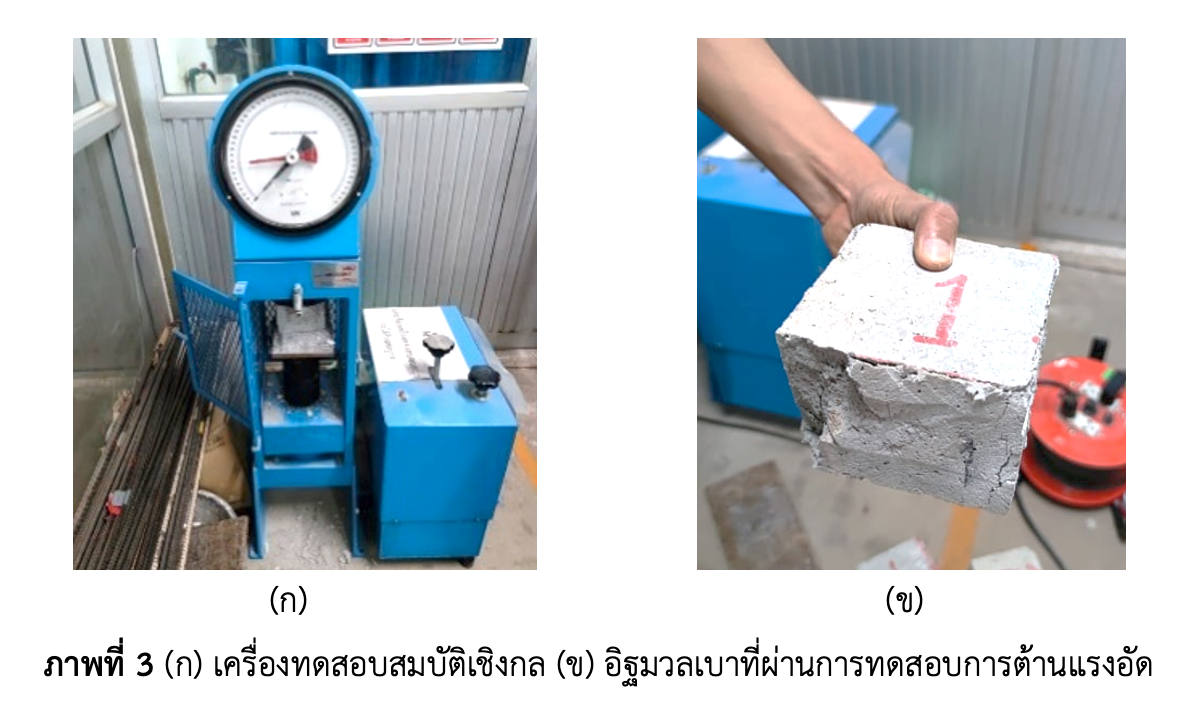ผลของวัสดุปอซโซลานเถ้าแกลบต่อสมบัติของอิฐมวลเบา
Main Article Content
บทคัดย่อ
การวิจัยนี้มีวัตถุประสงค์เพื่อศึกษาผลของการใช้เถ้าแกลบเป็นวัสดุเสริมกำลังในการผลิตอิฐมวลเบาขนาดความกว้าง 20 ซม. ความยาว 60 ซม. และความหนา 7.5 ซม. (ขนาดอิฐมวลเบาตามมาตรฐานของกรมส่งเสริมอุตสาหกรรม) การผลิตอิฐมวลเบาที่ไม่ผ่านกระบวนการอบไอน้ำ ประเภทที่ 1 ใช้วัสดุเบาร่วมในกระบวนการผลิต ได้แก่ ปูนซีเมนต์ปอร์ตแลนด์ ทรายละเอียด ผงอะลูมิเนียม ปูนขาว ยิปซั่ม และวัสดุเสริมกำลัง (แกลบบดละเอียด เผาที่อุณหภูมิ 600 องศาเซลเซียส สำหรับแทนที่ทราย จำนวน 3 สูตร ได้แก่ ร้อยละ 5, 10 และ 15 โดยน้ำหนัก) การบ่มอิฐใช้วิธีการขังน้ำเป็นระยะเวลา 7 วัน การทดสอบสมบัติของอิฐมวลเบา ได้แก่ ความต้านแรงอัด อัตราการดูดซึมน้ำ และความหนาแน่น วิเคราะห์ข้อมูลโดยใช้สถิติเชิงพรรณนา ได้แก่ ค่าเฉลี่ยและส่วนเบี่ยงเบนมาตรฐาน ผลการศึกษา พบว่า อิฐมวลเบาที่ผลิตขึ้นทั้งหมดมีความต้านแรงอัดระหว่าง 7.38 ± 0.42 ถึง 12.68 ± 1.27 เมกะพาสคัล ตัวอย่างที่ใช้เถ้าแกลบร้อยละ 10 ให้ค่าความต้านแรงอัดเฉลี่ย (12.68±1.27 เมกะพาสคัล) ใกล้เคียงกับชุดควบคุม (13.28 ± 0.42 เมกะพาสคัล) อัตราการดูดซึมน้ำ 15.4 ± 1.48 % ความหนาแน่น 1.47 ± 0.01 กิโลกรัมต่อลูกบาศก์เดซิเมตร และมีต้นทุนการผลิตด้านวัสดุประมาณ 16.47 บาท (137.2 บาทต่อตารางเมตร) ดังนั้น เถ้าแกลบสามารถนำมาใช้ประโยชน์ได้มากขึ้นด้วยการเป็นวัตถุดิบผลิตอิฐมวลเบา และสัดส่วนของเถ้าแกลบ ร้อยละ 10 โดยน้ำหนัก สามารถใช้ในการผลิตอิฐก่อผนังหรือกั้นห้องภายในอาคารที่ไม่ใช่ส่วนที่ต้องรับน้ำหนักโครงสร้างอาคารได้
Article Details

This work is licensed under a Creative Commons Attribution-NonCommercial-NoDerivatives 4.0 International License.
วารสารวิทยาศาสตร์และวิทยาศาสตร์ศึกษา (JSSE) เป็นผู้ถือลิสิทธิ์บทความทุกบทความที่เผยแพร่ใน JSSE นี้ ทั้งนี้ ผู้เขียนจะต้องส่งแบบโอนลิขสิทธิ์บทความฉบับที่มีรายมือชื่อของผู้เขียนหลักหรือผู้ที่ได้รับมอบอำนาจแทนผู้เขียนทุกนให้กับ JSSE ก่อนที่บทความจะมีการเผยแพร่ผ่านเว็บไซต์ของวารสาร
แบบโอนลิขสิทธิ์บทความ (Copyright Transfer Form)
ทางวารสาร JSSE ได้กำหนดให้มีการกรอกแบบโอนลิขสิทธิ์บทความให้ครบถ้วนและส่งมายังกองบรรณาธิการในข้อมูลเสริม (supplementary data) พร้อมกับนิพนธ์ต้นฉบับ (manuscript) ที่ส่งมาขอรับการตีพิมพ์ ทั้งนี้ ผู้เขียนหลัก (corresponding authors) หรือผู้รับมอบอำนาจ (ในฐานะตัวแทนของผู้เขียนทุกคน) สามารถดำเนินการโอนลิขสิทธิ์บทความแทนผู้เขียนทั้งหมดได้ ซึ่งสามารถอัพโหลดไฟล์บทความต้นฉบับ (Manuscript) และไฟล์แบบโอนลิขสิทธิ์บทความ (Copyright Transfer Form) ในเมนู “Upload Submission” ดังนี้
1. อัพโหลดไฟล์บทความต้นฉบับ (Manuscript) ในเมนูย่อย Article Component > Article Text
2. อัพโหลดไฟล์แบบโอนลิขสิทธิ์บทความ (Copyright Transfer Form) ในเมนูย่อย Article Component > Other
ดาวน์โหลด ไฟล์แบบโอนลิขสิทธิ์บทความ (Copyright Transfer Form)
References
Chaichana, V. (2019). Production of light brick using rice husk ash as an ingredient (in Thai). Research Report. Bangkok: Rajabhat Maha Sarakham University.
Chindaprasirt, P. and Jaturapitakkul, C. (2013). Cement Pozzolan and Concrete, 7thedition (in Thai). Bangkok: thailand concrete association.
Chindaprasirt, P., Songpiriyakij, S., Rattanasak, U. and Pruksanukul, S. (2020). Dimensional stability of Lightweight Concrete (in Thai). Research Report. Bangkok: Thailand Science Research and Innovation.
Dolah, N. (2009). Light materials used in construction Industry (in Thai). Princess of Naradhiwas University Journal, 1(3), 48-62.
Faculty of Engineering Civil Engineering University of Phayao. (2016). Determination of size, density, moisture and water absorption of bricks (in Thai). Retrieved 8 February 2022, from Faculty of Engineering Civil Engineering University of Phayao http://engineeringmaterialsproject.blogspot.com/2015/12/1.html
Ministry of Industry. (1998). Thai industrial standard (Tis no. 1505-2541) Autoclaved aerated lightweight concrete elements (in Thai). Retrieved 30 November 2021, from Ministry of Industry: http://www.fio.co.th/web/tisi_fio/fulltext/TIS1505-2541.pdf
Muangtong, P., Kongpun, T. and Nekhamanurak, B. (2014). Influence of Pozzolan Materials, Agricultural Waste, on Mechanical Properties of Soil-Cement Brick (in Thai). Research report. Bangkok: Rajamangala University of Technology Rattanakosin.
Office of the Basic Education Commission. (2021). Accounting of construction materials and labor costs for the year 2022 (in Thai). Retrieved 28 March 2022, from Office of the Basic Education Commission. https://rnedu.go.th/2019/wp-content/uploads/2021/11
Onprom, P. (2021). Influence of Glass Cullet as Partial Replacement of Fine Aggregate on Concrete Block Properties (in Thai). Vocational Education Innovation and Research Journal, 5(1), 32-39.
Panel hoszigeteles Co., Ltd. (2017). Properties of heat-insulating bricks or lightweight bricks (in Thai). Retrieved 8 February 2022, from Panel Hoszigeteles: https://www.panelhoszigeteles.com/category/%E0%B8%9C%E0%B8%A5%E0%B8%B4%E0%B8%95%E0%B8%A0%E0%B8%B1%E0%B8%93%E0%B8%91%E0%B9%8C/page/3
Sata, V., Tangpagasirt, J., Jaturapitakkul, C. and Chindaprasirt, P. (2012). Effect of W/B ratios on pozzolanic reaction of biomass ashes in Portland. Cement & Concrete Composites, 34(1), 94-100.
Sinsiri, T. (2014). High strength cellular aerated concrete (in Thai). Research report. Bangkok: Science and Technology Infrastructure Databank (STDB).
Sirisurawong, E. (2015). Development of the cement replacement material from water treatment sludge and rice husk ash (in Thai). Master’s Thesis. Nakhon Ratchasima: Suranaree University of Technology.
Senaart, N. and Nonthawee, P. (2019). Production of worm bricks from water supply sludge, Ubon Ratchathani University (in Thai). Research report. Ubon Ratchathani: Ubon Ratchathani University.
The securities and exchange commission. (2013). Smart concrete public company limited (in Thai). Retrieved 28 April 2022, from The Securities and Exchange Commission: http://capital.sec.or.th/webapp/corp_fin/datafile/69/2013/132800110401012013-04-

